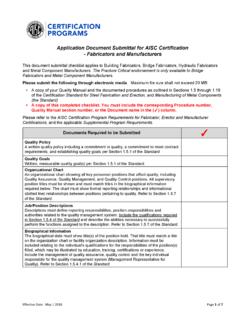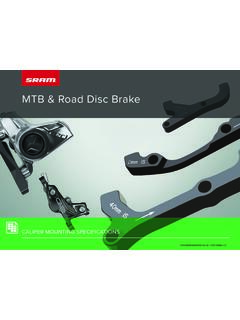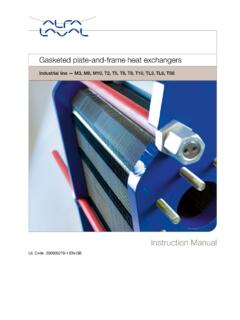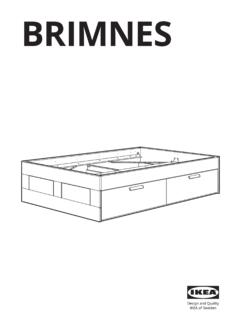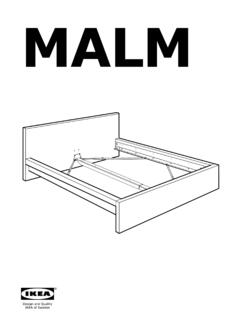Transcription of The Effective Length of Columns in Unbraced Frames - AISC
1 The Effective Length of Columns in Unbraced Frames J O S E P H A. YURA. T H E Effective Length concept for column design in Unbraced Frames has been incorporated in the A I S C. Specification since 1961. In simplified terms the concept is merely a method of mathematically reducing the problem of evaluating the critical stress for Columns in structures to that of equivalent pinned-end braced Columns . T h e Euler buckling stress for a column with r4r both ends pinned and no sidesway, (a) Sway (b) No Sway Fig. 7. Sway and no-sway buckling modes F< = 2 (1). (/A). can be used for all elastic column buckling problems by factors seems large to many engineers, especially since substituting an equivalent or Effective column Length Kl actual story heights were used in column design prior to in place of the actual column Length .
2 T h e Effective Length 1961. Consequently, the Effective Length concept appears factor K can be derived by performing a buckling anal- unreasonable to some designers. 3 However, as indicated ysis of the particular structure to determine the critical earlier, the Effective Length concept is a rational method stress. T h e pinned-end column with an equivalent Length of adjusting a common formula for a variety of condi- which gives the same critical stress establishes the K- tions. Therefore, if the factors appear unreasonable, the factor. T h e K-factor, then, is just a way of providing method of obtaining them, for example the alignment simple solutions to complex frame buckling problems.
3 Chart, should be examined more closely. T h e A I S C Specification requires the determination M u c h of the difficulty and misunderstanding of the of if-factors for Columns in Unbraced Frames by some Effective Length concept is due to the direct use of the rational analysis, that is, a stability analysis. T h e elastic alignment chart in situations which violate some of the solutions that have been developed indicate that the basic assumptions in the derivation of the nomograph. buckling will always occur in a sidesway mode, as shown in Fig. la. 1 The* buckling mode shown in Fig. l b , in which no sidesway occurs, is a more stable condition, and it corresponds to the braced frame case.
4 Bracing or oo. ^"20 oo 100- 10 , 100. some other shear resisting element must be present for t=50. the no-sidesway mode to govern. Bending moments in + the Columns due to beam gravity load do not significantly affect overall frame stability in the elastic range. 2 ; 4-3 0 S I / L Col. Most engineers use the alignment chart shown in S I / L Bm. Fig. 2, which provides approximate elastic solutions (A-factors) in lieu of an actual stability analysis (which can be very complex). T h e solutions summarized in the chart are based on sidesway buckling of a simplified elastic structure. T h e alignment chart always indicates K ^ iC-factors between and and even larger Sidesway values are not uncommon.
5 T h e magnitude of these Permitted o-i Joseph A. Yura is Associate Professor of Civil Engineering, Univer- sity of Texas, Austin, Texas. Fig. 2. Alignment chart for determining K-factors 37. APRIL / 1971. \. 1. T, i ELASTIC. \ 12. AISC * f Column Stresses v- \ E F. W16x40. I = 517 in! P=750k W16X40. T ^ a 12. \ - " " m-l E Fe do F 12. ^ " ^ v -H- -H- K//r 24 24. Fzg. 3. AISC column stresses Hg. 4. Design Example 1. T w o of the principal assumptions a r e : In the elastic range, E cancels from Eq. (3), resulting 1. Elastic action in the familar expression for G given in Fig. 2. When the 2. All Columns in a story buckle simultaneously KL/r of a column is less than Cc, axial column behavior is inelastic.
6 T h e column stiffness ETI/L is less than the A variety of practical situations exists in which one or elastic value. Hence, an elastic beam offers more relative both of these assumptions are inaccurate a n d use of the restraint to such a column. In the inelastic range of alignment chart produces overly conservative designs. column behavior, the end restraint factor G may be T h e development of design methods to handle such defined by situations will now be presented. 2(ETI/L)c0l Erp G. (4). 2(EI/L)beam ~E. INELASTIC Columns . T h e A I S C allowable column stress Fa is a function of T h e value of G normally used in the alignment chart is Kl/r, as shown in Fig.
7 3. Because of residual stresses reduced by the factor ET/E. If G is reduced, the effec- and initial out-of-straightness, inelastic action is assumed tive Length is also smaller. T h e Effective Length of Columns to begin at an average stress level of T h e value in the inelastic range can be determined by the align- of Kl/r corresponding to this stress level is called Cc, ment chart if the reduced Gineiastic is used. T h e only and it defines the assumed boundary between elastic a n d problem is to determine the factor ET/E. This can be inelastic action. For A36 steel (Fy = 36 ksi), Cc = 126, accomplished in a reasonably accurate manner by which means that most Columns in multistory structures noting that for a given Kl/r*.
8 Will be in the inelastic range. T h e stiffness of a column in the elastic range is proportional to EI; however, the cr (inelastic) EL. E F'. column stiffness in the inelastic range can be more accurately taken as proportional to a reduced stiffness so E q . (4) reduces to ETI, where ET is the tangent modulus. T h e inelastic buckling stress is then ^inelastic n/ ^elastic (5). F'e Fc,r In the elastic range, Fa = F'e, so the nomograph pro- (2). Q/r) cedures would be unchanged. Equation (5) has been developed by others in a slightly different form. 4 - 5 The In the development of the alignment chart for column use of Eq.
9 (5) is rather simple, and its use will be illus- buckling in framed structures, the buckling strength was trated in the following design example. found to be related to Column Stiffness 2(EI/L)c0i G = (3) * Fa and Fj use different factors of safety, but this is ignored as a Beam Stiffness 2(EI/L)beam minor factor in the development. 38. AISC ENGINEERING JOURNAL. D e s i g n Example 1 Design column AB in the Unbraced frame shown in Fig. 4 to support 750 kips, using A36. steel (Fy = 36 ksi). Only in-plane behavior will be considered for illustrative purposes. I n the design, assume the column above and below are not significantly different in size.
10 Elastic Solution: Fig. 5. Column bracing in Unbraced Frames TryWl4X150: 4 2. Ix = 1790 in. , rx = in., A = in. 2 179Q 12 T h e design example shows that the inelastic approach r r ( / ) ,c GA =. B =. 2 (517/24) = 6 93. ' can produce significant reductions in the Effective Length factor. When the elastic KL/r is reasonably low (about From the alignment chart, K = 50 or less), the actual K will usually converge to , KL/rx = (144) = 58, Fa = ksi although no specific rule has yet been established. This observation indicates that Columns in multistory Frames Paiiow = ( ) = 776 > 750 kips can often be designed on the basis of K = ; that is, UseWl4X150.




